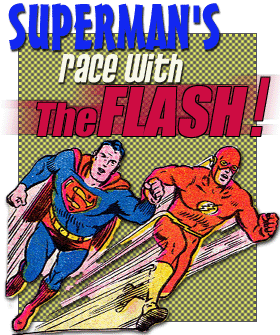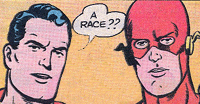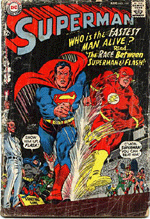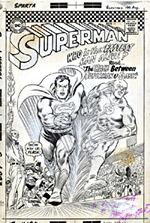 Sure
Superman was the first superhero, but I'm willing
to bet that the very day the second one came along,
that's when the debates began; who's better, my hero or
yours?
Sure
Superman was the first superhero, but I'm willing
to bet that the very day the second one came along,
that's when the debates began; who's better, my hero or
yours?
Six decades later, for all the supposed advances in printing
and storytelling and theoretical maturity of modern readers,
that's still pretty much what most fans are arguing about.
Could the Thing beat the Hulk in a city-shaking free-for-all?
Could Batman out-fight Daredevil? Does Aquaman rule the
seas, or Sub-Mariner? Who's the better marksman...Green
Arrow or Hawkeye?
And of course, who's faster, Superman or the Flash?
We seemed to get conflicting accounts. Superman could
fly across the galaxy in a twinkling. He could move so
quickly that he broke not only the barriers of sound and
light, but that of time itself. And yet, Barry "Flash"
Allen was billed as "The Fastest Man Alive,"
circling the globe in less than a second, vibrating at
such speeds that he passed through solid objects and jogging
quickly enough to run over bodies of water without sinking,
or up the sides of buildings without falling. Sooner or
later, we would have to settle this issue once and for
all...which hero was really the fastest?
 It's
hard to believe it took DC so long to capitalize on the
sales potential in this idea. After all, if there's one
thing kids can relate to, it's a good, old-fashioned foot
race. "Race you to the slide!," they
yell. "Catch me if you can!" "Last one
home is a rotten egg!" Perhaps it's no surprise,
then, that the writer who finally got around to telling
the tale was young Jim Shooter, the teenage wunkerkind
who produced so many classic tales of teen romance, adventure
and angst for the Legion of Super-Heroes. Who better to
understand what kids want than another kid?
It's
hard to believe it took DC so long to capitalize on the
sales potential in this idea. After all, if there's one
thing kids can relate to, it's a good, old-fashioned foot
race. "Race you to the slide!," they
yell. "Catch me if you can!" "Last one
home is a rotten egg!" Perhaps it's no surprise,
then, that the writer who finally got around to telling
the tale was young Jim Shooter, the teenage wunkerkind
who produced so many classic tales of teen romance, adventure
and angst for the Legion of Super-Heroes. Who better to
understand what kids want than another kid?
What resulted was a fantastic piece of storytelling,
a near-perfect blend of humor, suspense and action that's
still remembered fondly today. Making this adventure all
the more remarkable is the fact that there is no real
villain, in the usual comic book sense. But there are
plenty of opportunities for heroism, good deeds and sportsmanship.
Superman and the Flash emerge as two incredibly decent
guys, bending over backward to help each other, purposely
avoiding opportunities to exploit each other's weaknesses
and, wherever possible, slowing down enough to help others
along the path established for their competition. All
of which, in the spirit of the times, are held up as right
and proper things to do, and not at all "dorky"
or "camp."
 This
story appeals to me for several reasons. For one thing,
it's a tremendous showcase for the art of Curt Swan and
George Klein, who are called upon to portray locales as
varied as San Francisco, Afghanistan, Iraq and Australia
as the heroes race from arid deserts to storm-tossed oceans,
dense rainforests to frozen tundras, quaint villages to
great cities. Also, it's a neat example of how heroes can
be pitted against each other without resorting to tired
cliches of brain-washing, mistaken identity or miscommunication.
Both heroes are at their full power and possessed of all
their faculties, making this a real match-up (even if the
outcome is pretty predictable).
This
story appeals to me for several reasons. For one thing,
it's a tremendous showcase for the art of Curt Swan and
George Klein, who are called upon to portray locales as
varied as San Francisco, Afghanistan, Iraq and Australia
as the heroes race from arid deserts to storm-tossed oceans,
dense rainforests to frozen tundras, quaint villages to
great cities. Also, it's a neat example of how heroes can
be pitted against each other without resorting to tired
cliches of brain-washing, mistaken identity or miscommunication.
Both heroes are at their full power and possessed of all
their faculties, making this a real match-up (even if the
outcome is pretty predictable).
Contrast this to Marvel Comics, where in any given month,
two heroes meeting for the first time will, as a matter
of course, pound the daylights out of each other until
realizing they're both on the same side. At DC, things
were different, as heroes tended to ask questions first
and start pounding later. "Superman's Race With The
Flash" was a masterful way for DC to have their cake
and eat it, too, pitting two heroes against each other
in a contest readers really wanted to see, but without
turning them into the reckless hot-heads their Marvel
counterparts often were, and all in the spirit of healthy
athletic competition, not "I'll rip your head off"
rage.
 Considering
the "big event" potential inherent in this concept,
it's interesting to note that "Superman's
Race With the Flash" was relegated to Superman
No. 199, and not the milestone 200th issue that followed
(in fact, issue 200 was a fairly unmemorable "Imaginary
Tale"). But the proof's in the pudding, as all these
years later, Superman 199 remains one of the best-remembered,
most sought-after and priciest of Superman back-issues.
Considering
the "big event" potential inherent in this concept,
it's interesting to note that "Superman's
Race With the Flash" was relegated to Superman
No. 199, and not the milestone 200th issue that followed
(in fact, issue 200 was a fairly unmemorable "Imaginary
Tale"). But the proof's in the pudding, as all these
years later, Superman 199 remains one of the best-remembered,
most sought-after and priciest of Superman back-issues.
More than that, it featured one of the most famous covers
of the Silver Age, inspiring countless "homages"
and swipes as recently as the mid-90s. Pencilled by Carmine
Infantino and inked by Murphy Anderson, a scan of the
original art is pictured at right.
Another sure sign that the story was well-received is
the fact that there have been numerous re-matches over
the years. For an overview of all the races between Superman
and the Flash, check out this handy link: http://www.hyperborea.org/flash/races.html
In the meantime, enjoy the
first, and to my mind greatest showdown between the
Man of Steel and the Scarlet Speedster.


 Sure
Superman was the first superhero, but I'm willing
to bet that the very day the second one came along,
that's when the debates began; who's better, my hero or
yours?
Sure
Superman was the first superhero, but I'm willing
to bet that the very day the second one came along,
that's when the debates began; who's better, my hero or
yours?  It's
hard to believe it took DC so long to capitalize on the
sales potential in this idea. After all, if there's one
thing kids can relate to, it's a good, old-fashioned foot
race. "Race you to the slide!," they
yell. "Catch me if you can!" "Last one
home is a rotten egg!" Perhaps it's no surprise,
then, that the writer who finally got around to telling
the tale was young Jim Shooter, the teenage wunkerkind
who produced so many classic tales of teen romance, adventure
and angst for the Legion of Super-Heroes. Who better to
understand what kids want than another kid?
It's
hard to believe it took DC so long to capitalize on the
sales potential in this idea. After all, if there's one
thing kids can relate to, it's a good, old-fashioned foot
race. "Race you to the slide!," they
yell. "Catch me if you can!" "Last one
home is a rotten egg!" Perhaps it's no surprise,
then, that the writer who finally got around to telling
the tale was young Jim Shooter, the teenage wunkerkind
who produced so many classic tales of teen romance, adventure
and angst for the Legion of Super-Heroes. Who better to
understand what kids want than another kid? 

